
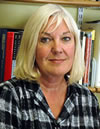 This entry is written and dedicated to the memory of Dr Carole Mallia, 1951-2014, History Department, University of Nottingham. Carole had been researching James Woodford as part of her family tree research and had found out that he was related to her through her mother. She had visited Woodford’s family before her illness became too invasive for her to continue. This is a fitting tribute to an inspirational and dedicated teacher, gifted scholar and much loved member of staff.
This entry is written and dedicated to the memory of Dr Carole Mallia, 1951-2014, History Department, University of Nottingham. Carole had been researching James Woodford as part of her family tree research and had found out that he was related to her through her mother. She had visited Woodford’s family before her illness became too invasive for her to continue. This is a fitting tribute to an inspirational and dedicated teacher, gifted scholar and much loved member of staff.
James Arthur Woodford O.B.E. R.A. F.R.B.S. (25 Nov 1893-8 Nov 1976)
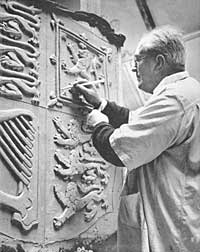
J. A. Woodford at work (photograph courtesy of James Woodford).
James Arthur Woodford will always be remembered by Nottingham for two important pieces that remain as a celebration to his life and work. They are the art deco statue of ‘Prosperity’ on the north- east corner of the Nottingham Council House and the other is the Robin Hood statue which stands outside the Nottingham Castle. He was a prolific sculptor and artist but while he trained locally most of his works are in various other towns of the UK.
James Arthur Woodford was born in Nottingham on 25 November 1893, the son of Samuel Woodford a Lever lace designer, one of the few left in the city of Nottingham. The family resided at two addresses on Alfred Street South (numbers 36 and 38) over a period of time. There is little known about his schooling but ironically he used to watch the Sherwood Foresters drilling in front of Nottingham Castle. According to family history he had a garret in the family house where he did his sculpting. The first piece he did was a baby with a tear on its cheek for his mother. He won a scholarship to study at the School of Art, Waverley Street, Nottingham. He was awarded three gold medals for sculpture. With the outbreak of the First World War he enlisted in 1915 and served with the 11th Battalion Nottinghamshire and Derbyshire Regiment (Sherwood Foresters) and was ‘Mentioned in Despatches’.
When the war ended he returned to his passion and trained at the Royal College of Art in London and was the winner of the Prix de Rome for Sculpture in 1922 and later Rome Scholar 1922-25. This gave him the opportunity to travel for three years in France, Italy, Switzerland and Greece from where he no doubt took inspiration. On his return to England he was busy and in 1927 he exhibited at Leeds City Art Gallery a work entitled ‘Bambino’; a further exhibit of the ‘female torso’ was shown in the same year at the City of Manchester Art Gallery. In 1928 he exhibited at the Nottingham Castle Museum for local artists a piece entitled ‘Madonna and child’. One of Woodford’s first important assignments was to be involved in the work on the new Nottingham Council House which was begun in 1927 with the laying of the foundation stone and completed in 1929 when it was formally opened. His Art Deco statue of ‘Prosperity’ is on the north east corner of the building where the Dome rises from the square base and is best seen from Long Row East.
By this time Woodford was living in London and had married Rose Harrison. They had one son. Woodford continued to live in London for much of the rest of his life. He continued to exhibit throughout the United Kingdom, including in Aberdeen and Leicester. His work was varied and included the arms of Corpus Christi College, Cambridge in the chapel; the three feathers of the Prince of Wales, 6 feet high for a tenement block at Kennington, London part of the estate of the Duchy of Cornwall and a bronze group of the ‘Vallee Pietra’ now in the Leicester Gallery. He worked on the main door of the Institute of the Blind in Liverpool and his work brought him prominence and attracted the attention of Mr G G Worman, the architect designing the Royal Institute of British Architects at 66 Portland Place. In 1934 Woodford was asked to create the doors for this building which was a mammoth task as the doors are of bronze, each door is 12 feet high by 6 feet wide (3.65m by 1.82m) and weighs 1.5 tons. The doors depict London’s river and its buildings and flowing across their surface are representations of the Thames. An eclectic mix of ancient and what was then considered modern architecture in London are interspersed around the river and coat of arms relating to the local area. Buildings featured on the doors include: St. Paul’s Cathedral, a London Underground tunnel, London Zoo, an LCC tenement, and the former RIBA HQ at 9 Conduit Street. As well as buildings, on the doors in relief are people, wildlife, and various modes of transport from London. He also made figures on the exterior columns, interior ceiling plaster reliefs depicting the main periods of English architecture and various building trades and crafts.
Around the same time Woodford was engaged in creating some decorative work for the Cunard liner, RMS Queen Mary, which was launched in 1934, carving wooden screens and designing bronze uplighters for the cabin class smoking room. He continued to exhibit at various exhibitions around the country. Four years later in 1938 he made a set of 18 sculptured roundels for the six bronze door for the modern Norwich City Hall, each depicting a manual trade that had been practised in the city. A year later he went on to produce stone figures and panels for Huddersfield Library and Art Gallery and the sculptures on either side of the main entrance. The building was opened in 1940. Once again Woodford had to put his work to the side during the Second World War (1939-1945) and he became a camouflage officer with the Air Ministry. After the war he continued with his work both producing material for exhibitions, serving on various artistic committees and becoming a leading member of various Academies, including Royal Society of British Sculptors, member of the Royal Mint, Royal Academy of Arts and Art Worker’s Guild.
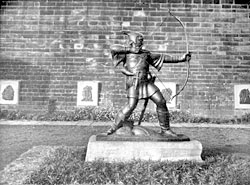
The Robin Hood statue outside Nottingham castle in the early 1950s.
At the beginning of the 1950s Woodford was commissioned to create a statue of Robin Hood to stand outside the castle in Nottingham. The sculptor had meticulously researched the details for his subject and created a stocky-built figure that depicted how the historians believed medieval foresters from the period would look. His lasting legacy to Nottingham has not been without controversy. “A pudgy statue with fat legs…not a bit like Errol Flynn” was how it was once described! Cast in eight pieces of half-inch thick bronze (made to last 6,000 years) and weighing half a ton, the 7ft effigy of Nottingham's legendary outlaw proudly stood on a two-and-a-half ton block of white Clipsham stone. It was officially unveiled in 1952, having been gifted to the city by local businessman and benefactor, Philip E F Clay. The cost to the Council for its siting was nearly £2,000, the equivalent of £55,000 today. A costly piece of work! Over the years the statue has suffered at the hands of vandals. In particular the arrows were repeatedly stolen and they cost the council £55 each time they were replaced. Ironically, it was a former Sheriff of Nottingham, Alderman Frank Dennett who came to Robin's aid and enlisted the services of the engineers at the Royal Ordnance Factory, who made the arrow from a particularly strong material fixed with a specialised welding process to deter the vandals. In the end though it was decided to forego the arrow and leave it to the imagination.
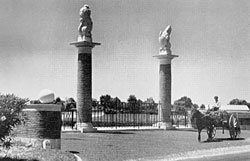
Heraldic beasts at Minturno War Cemetery (photograph courtesy of James Woodford).
Two of the many war cemeteries built for the Imperial War Graves Commission after the Second World War were at Bolsena, and Minturno, Italy. It was at Bolsena that the 6th South African Armoured Division fought a heavy battle with the retreating German army in 1944. Bolsena War Cemetery contains 600 graves and of these 185 are of South Africans. Woodford created free-standing heraldic beasts for both of these cemeteries. At Bolsena a vertical lion of England is depicted slaying the dragon and at Minturno a 6 foot high lion and unicorn, carved in situ from local stone, Travertine, stand on 20 foot high brick columns in the main thoroughfare.
The theme of heraldic beasts was to be found in Woodford’s next very important commissions. Lions and Unicorns designed by Woodford were to be incorporated in four arches dominating the trees of the Mall for the Coronation in 1953. The arches were to have four legs, each interlocking 65 feet above the roadway and at each summit, where they intersect the metal gold lions and white unicorns were to rear up in groups of four. However, probably the pinnacle of his career was the commission to design and create ten heraldic beasts – forever known as the Queen’s Beasts, for the Coronation of Queen Elizabeth II in 1953. These included the Lion of England, Unicorn of Scotland, Falcon of the Plantagenets, Griffin of Edward III, Bull of Clarence, White Lion of Mortimer, Greyhound and Dragon of the Tudors, Yale of the Beauforts and White Horse of Hanover. They were placed externally against the walls to a temporary entrance to Westminster Abbey, providing robing rooms and marshalling space for the royal procession before entering the Abbey. They were cast in plaster and painted. The originals were made of plaster and were not intended to be permanent. Their future was uncertain until the Canadian Government in 1959 took them and placed them in the Canadian Museum of Civilization, Gatineau. Replicas of these 10 figures, were to be set up in front of the Palm House in The Royal Botanical Gardens, Kew. Funds for these replicas came from an anonymous donor. Woodford and his four assistants worked for over a year copying the figures in Portland stone – each weighing about one ton.
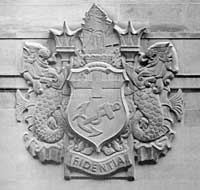
Coat of Arms on Lloyds building on Lime Street, London from 1954 (photograph courtesy of James Woodford).
Following his work for the Coronation, Woodford carried out a number of important commissions. He created a coat of arms, in Portland stone, for the new Lloyd’s building, main entrance, on Lime Street, London. The relief was very bold in order that it could be correctly interpreted from street level. They were 8 feet by 9 feet with a depth of 8 inches. When the building was demolished, the panels were preserved and later positioned at street level on the Willis building, erected on the same site in the financial district of the City of London. Another banking institute, Barclays, used Woodford’s design. The spread eagle was one of the many signs used in the City of London and was retained and incorporated with the three crowns in the grant of arms of Barclays Bank in 1937.
During the late 1950s and 1960s Woodford was kept very busy creating a more modern design for the royal coat-of-arms, which used Latin rather than Gothic and incorporated floral emblems of the United Kingdom. The building of a number of new County Courts provided him with the opportunity to design the royal coat of arms for a variety of settings; materials such as wood, stone and aluminium were used and in the case of Hanley in the Potteries he used faience to reflect the character of the area. In 1960 he was commissioned to make some scenic decorations in hard white plaster for the Carpenter’s Company hall in Throgmorton Street, London. He studied their history and designed sixteen notable events. In 1962 he created the coat of arms for Devon County Hall, Exeter, which was sited on the main wall of the council chamber; it is of carved oak 6’ 6” by 5’ 6”, with a depth of 4 inches, and pierced to show the silhouette.
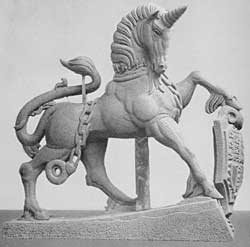
Unicorn at Tehran Embassy (photograph courtesy of James Woodford).
Throughout his career the heraldic beast played an important part of Woodford’s sculpting. In 1966 he was commissioned to make a lion and a unicorn in bronze to stand at the gates of the British Embassy in Tehran. The beasts were 6’ high and stood on a pedestal of the same height. They were made at the Lambeth foundry.
He was a prolific artist and many of his works can still be seen around the country today. In his seventies he was working and in 1969 he executed a lion and a unicorn, both 6’ high, in aluminium and stove enamelled to stand either side of the main entrance of Wandsworth County Court, London.
Although many of the major, larger commissions are visible, the location of other smaller and exhibition pieces are unknown.
He became an Associate member of the Royal Society of British Sculptors in 1937 and a full member in 1945 and elected Senior Royal Academy in 1968 and was a fellow of the Royal Society of British Sculptors. He was a Royal Academician for 31 years and the sole survivor of the ‘Nottingham circle’ at the Royal Academy which had included Dame Laura Knight. He was a committee member of the Royal Mint in 1946 serving on the Royal Mint Committee of Medals and Seals. He was awarded the OBE in 1959.
He died on 8 November 1976, aged 83 years, at his home in London and was cremated at Golders Green Crematorium.